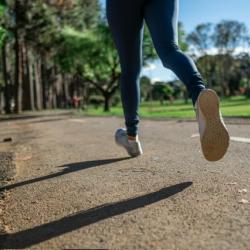Being one of the most popular forms of exercise worldwide, running is also one of the most common causes of injury that we see in the clinic. But - it is important to remember that most of these injuries are very avoidable; there are some simple steps that you can take to stay on the ‘right side of your training’.
In this blog post our physiotherapist Liam and podiatrist Michael have joined up to give you tips on how you can start to prepare for the London Marathon 2025. But you don’t have to be aiming to run a marathon, or even a half-marathon, to benefit from the advice they are sharing. It is just as relevant if you are new to running and aim to complete a 5k charity run for example. Whether you're a seasoned runner or a first-time marathoner, following a strategic plan is essential for a successful race.
So let’s start with the feet. Because no matter how fit you are, you won’t run far with ‘bad’ feet.
Good foot health extends beyond our feet, it involves the way we walk, run, which muscles, do we overcompensate, etc.
Please read on for our podiatrist Michael’s advice from a foot health perspective.
Running Shoe Selection
Selecting the right running shoes is crucial for comfort, performance, and injury prevention. Here’s how to choose the best pair:
- Understand Your Foot Type: Determine if you have flat feet, high arches, or neutral arches. This helps in choosing shoes with the right support and cushioning.
- Get Fitted Professionally: Visit a specialty running store where experts can analyse your gait and recommend the best shoe options for your running style and foot type.
- Consider Your Training Terrain: Choose shoes that match the surfaces you’ll be running on, whether it’s pavement, trails, or a treadmill.
- Allow for Toe Space: Ensure there is about a thumb’s width of space between your longest toe and the end of the shoe to accommodate foot swelling during long runs.
- Replace Worn-Out Shoes: Running shoes typically need to be replaced every 300-500 miles. Keep track of your mileage and look for signs of wear.
Building Up Distances
Gradually increasing your running distance is key to building endurance and preventing injuries. Follow these steps:
- Start Slowly: Begin with shorter distances if you're new to running. Aim for 3-4 runs per week, starting with 2-3 miles per run.
- Follow the 10% Rule: Increase your weekly mileage by no more than 10% to avoid overuse injuries. For instance, if you run 10 miles one week, aim for no more than 11 miles the following week.
- Incorporate Long Runs: Include one long run each week, gradually increasing the distance. For marathon training, your long runs should eventually reach 18-20 miles.
- Balance with Rest: Allow your body to recover with rest days and low-impact cross-training activities such as swimming or cycling.
- Taper Before the Race: Reduce your mileage in the last three weeks before the marathon to ensure your body is well rested and ready for race day.
Warm-Up and Cool-Down Routine
A proper warm-up and cool-down routine can enhance your performance and reduce injury risk.
Warm-Up Routine
- Dynamic Stretching: Perform dynamic stretches such as leg swings, arm circles, and walking lunges to increase blood flow and flexibility.
- Gradual Intensity Increase: Start with a slow jog for 5-10 minutes to gradually raise your heart rate.
- Drills and Strides: Incorporate running drills and strides (short bursts of running at a faster pace) to prepare your muscles for the intensity of the run.
Cool-Down Routine
- Gradual Slow Down: After your run, gradually reduce your pace to a slow jog or walk for 5-10 minutes.
- Static Stretching: Focus on stretching the major muscle groups used during the run, holding each stretch for 20-30 seconds. Key areas include the hamstrings, quadriceps, calves, and hip flexors.
- Hydrate and Refuel: Rehydrate with water or an electrolyte drink and refuel with a snack rich in protein and carbohydrates to aid in recovery.
- Foam Rolling: Use a foam roller to massage out tight spots and improve muscle recovery.
Foot Care: Avoiding Blisters and Black Toenails
Proper foot care is essential to prevent common running issues like blisters and black toenails.
- Choose the Right Socks: Wear moisture-wicking socks made of synthetic materials to reduce friction and keep your feet dry.
- Lubricate Your Feet: Apply a thin layer of petroleum jelly or a specialized anti-chafing product on areas prone to blisters before running.
- Keep Toenails Trimmed: Regularly trim your toenails to prevent them from hitting the front of your shoes and causing black toenails.
- Break in Your Shoes: Gradually break in new shoes before long runs to avoid blisters. Start with shorter runs to allow the shoes to mould to your feet.
- Address Hot Spots Immediately: If you feel a hotspot during a run, stop and apply a blister bandage or adjust your shoes to prevent a blister from forming.
- Foot care appointment: have callus reduced on any border/area prone to blistering at around 2 weeks before any long race.
Now on to the tips and advice our physiotherapist Liam has to share:
Planning - It may sound overly simplistic but planning is very important.
If your goal is a to complete a marathon, for example, then the planning is crucial. If your goal is a few runs a weeks just to stay fit then it is less important but still something to think about. For instance the beloved ‘Couch to 5k’ program is great for getting started. Anything that gets people started to move we love, however the progression may not fit all in terms of distance, time, speed or injury management and would benefit from a more bespoke program.
Distances should be increased slowly and in accordance with what your body is telling you. Often, I see large percentage increases on the weekend ‘long run’ along with increases on they typically lighter weekday runs. Without knowing it you could be running 15-20% more in one week than you were previously. This is a lot for the body to cope with especially if you are to progress again next week. You wouldn't increase your strength work in the gym by the same amount, and so your running should be considered in a similar way.
Strength Training
Routinely over looked, or lumped in with interval or speed work, proper strength training does more than just build muscle. It programs your brain to work better with that specific muscle group. Take the glutes for example: This is an area where people often seem to get lost. Exercising your glutes is not just about squats. Done poorly, you may never even recruit the glutes in this exercise. Your need to connect with the muscle neutrally during the exercise your have elected, and this needs to be applied to your running! You should be able to use your glutes while running and actually feel them being used. Without this, injuries such as knee pain, ‘faulty mechanics’, will simply continue despite your efforts in the gym.
Joint mobility
All the joints of your body should have good mobility, as they all work together to provide you with good movement. Poor ankle mobility will have a huge effect on knee placement and can lead to over use issues. Poor hip internal or external rotation can have similar effect on the knee and can lead to excessive back pain when running. Having good mobility is not simply stretching, it involves moving the body in ways to place joints in positions the may not get into in your day to day, all while stretching the connective tissues. This can prevent lots of things such as cartilage breakdown or ligament inflammation.
Work on your running
Think about things like stride length and cadence (step rate per minute). These can have large influence on the forces that your body must cope with when you are training. The figures can vary, but recent studies have found that your foot and ankle can absorb around 3-4 times your body weight per stride when walking at a brisk pace. When you increase this to running, with slow cadence, you may land very heavily on your feet, and this can lead to joint and muscle fatigue.
All of these things can be assessed by a physiotherapist. Your physiotherapist will be well placed to focus on strength work and integration into your overall training program, which should also be looked at by a podiatrist. Podiatry is invaluable when it comes to footwear selection and the overall mechanic of the foot and lower limb.
Preparing for a long run requires a comprehensive approach that includes selecting the right running shoes, gradually building up your distances, and incorporating effective warm-up and cool-down routines. Additionally, taking good care of your feet can prevent common issues like blisters and black toenails, ensuring a more comfortable and successful race experience.
At the White Hart Clinic we are dedicated to providing comprehensive care and support for all your health and wellness needs. Our team of therapists are here to help you achieve your fitness goals with personalised training plans, expert advice, and a holistic approach to health. Contact us to learn more about our services and how we can assist you in your running journey.
Good luck, and happy running!
Our Barnes Clinic
Our clinic is located in Barnes, South-West London and is easily accessible by public transport.
For more information including parking and other practicalities see our Barnes clinic page
Book an Appointment
Booking an appointment with one of our therapists is quick and easy. There is no long waiting time and you don’t need a referral from your GP.




